 Following reports yesterday of difficulty between Toshiba and Sony in agreeing on the Unified DVD format, bringing together HD-DVD and Blu-Ray, we’ve spoken to Sony and they have confirmed difficulties.
Following reports yesterday of difficulty between Toshiba and Sony in agreeing on the Unified DVD format, bringing together HD-DVD and Blu-Ray, we’ve spoken to Sony and they have confirmed difficulties.
Disc capacity
Blu-Ray, surprise, surprise uses a blue laser, as does HD-DVD. They didn’t just like blue lasers because it fits in with their name, or even that it’s their favorite colour, the shorter wavelength of the blue light, 405nm, (think of its position in the rainbow relative to the red, 650nm) allowed for higher density of their disks. Current CD and DVD media uses red lasers.
The difference in capacity of the two formats is pretty large. A single layer disc yields quite a difference – HD-DVD provides 15GB, and Blu-Ray 25GB.
Blu-Ray are claiming that their eight layer disks can hold 200GB of content, a considerable amount in anyone’s book. They’ve also told us they’re working on ten and twelve layer disks, pushing storage even higher to 300Gb. HD-DVD holds 30GB on their dual layer disks.
Why extra capacity is a sticking point
Many may wonder why 200GB is needed for a disk (not you, dear reader, I’m sure). Well while the storage requirements of HD content has a small part to do with it, the obvious use is to provide near-endless ‘extra’ material to go with the film on the disk (even if the purchaser isn’t interested in it). Less obviously, is placing material on the disk that is locked.
 We think that Blu-Ray’s dogged pursuit for high capacity (possibly in the face of Unified DVD), and the fact that Sony are driving Blu-Ray is no coincidence.
We think that Blu-Ray’s dogged pursuit for high capacity (possibly in the face of Unified DVD), and the fact that Sony are driving Blu-Ray is no coincidence.
Sony, having learnt its lesson during the Betamax/VHS wars, now own a serious amount of content and the studios want to make more. We imagine that the content side of Sony’s business is pushing hard to extra capacity for commercial reasons.
Think about it – what do media companies want to do? Reduce the involvement of the middle man, or cut it out completely. If they are able to sell a disk with one accessible film on it, plus a number of films on it that are locked, they’ve reduced their distribution costs, and importantly, kept percentage paid to the retailer to a minimum. To access the extra films, the purchaser simply has to contact the media owner.
An important part of the Blu-Ray standard is its online capabilities, so the unlocking could be requested and paid for through the player, or via the phone for the die hards. The great thing, at least in the eyes on the media owner, is that the additional income generated is nearly all profit.
Difference in programming One thing that appears to have been missed by most commendations on Unified DVD is the world of difference in the programmability of HD-DVD and Blu-Ray. As a player supporting both standards isn’t realistic, one of the sides would have to change completely. This leads to considerable additional cost for the media creator, forcing them to effectively have to programme the whole disc twice.
 Cover layer thickness difference
Cover layer thickness difference
This is possibly the unbridgeable gap. Cover layer thickness – how close the information is written to the surface of the physical disc. Blu-Ray is 0.1mm and HD-DVD is 0.6mm. HD-DVD has plumbed for the 0.6mm, the same standard as current DVD’s. From our discussion, this appears to be an intractable difference.
The difference in layer thickness is one of the factors that makes manufacturing Blu-Ray discs more expensive, as the equipment used to create the disc has to be replaced.
Both sides have been busy gathering supporters of their own formats, in a not dissimilar way to two groups at school picking teams in the playground, trumpeting when another new chum joins their gang.
It will be a great shame if Unified DVD does fail. We all know what will happen – everyone suffers from the producers of the content to the consumer. At this time, it looks like we’re going to have to prepare for that.
HD-DVD
Blu-Ray
 Deutsche Telekom have just announced that they will be rolling out 50 Mbit/s connection in 50 cities around Germany by 2007.
Deutsche Telekom have just announced that they will be rolling out 50 Mbit/s connection in 50 cities around Germany by 2007. The “we’ll make the country globally competitive by installing high speed Internet access, but it needs to be made worth our while” argument has been used before by other incumbent telcos when they are trying to get good, or better deals from the regulators.
The “we’ll make the country globally competitive by installing high speed Internet access, but it needs to be made worth our while” argument has been used before by other incumbent telcos when they are trying to get good, or better deals from the regulators. From deep within the Microsoft base, Bill Gates has pulled a few levers and dispatched a corporate grabbing tentacle in the direction of Teleo, a privately held provider of VoIP software and services.
From deep within the Microsoft base, Bill Gates has pulled a few levers and dispatched a corporate grabbing tentacle in the direction of Teleo, a privately held provider of VoIP software and services.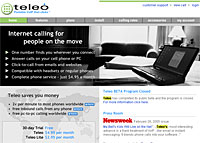 The San Francisco-based outfit Teleo was founded just two years ago and got as far offering a beta PC to PC or standard phone Skype-like VoIP service with click-to-call dialing through Microsoft Outlook and Internet Explorer before Gates grabbed the product.
The San Francisco-based outfit Teleo was founded just two years ago and got as far offering a beta PC to PC or standard phone Skype-like VoIP service with click-to-call dialing through Microsoft Outlook and Internet Explorer before Gates grabbed the product. Terms of the deal haven’t been disclosed, but Microsoft have said that members of the Teleo executive team will continue to work closely with MSN, while some Teleo product developers are expected to shuffle across and join MSN.
Terms of the deal haven’t been disclosed, but Microsoft have said that members of the Teleo executive team will continue to work closely with MSN, while some Teleo product developers are expected to shuffle across and join MSN. Following
Following 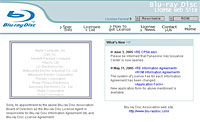 We think that Blu-Ray’s dogged pursuit for high capacity (possibly in the face of Unified DVD), and the fact that Sony are driving Blu-Ray is no coincidence.
We think that Blu-Ray’s dogged pursuit for high capacity (possibly in the face of Unified DVD), and the fact that Sony are driving Blu-Ray is no coincidence.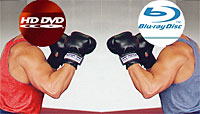 Cover layer thickness difference
Cover layer thickness difference The long-anticipated launch of HomePlug AV specification has finally reached its public release on Thursday last week.
The long-anticipated launch of HomePlug AV specification has finally reached its public release on Thursday last week. The body started in Q1 2000 and knocked out its first specification, HomePlug 1.0 in spring 2001. 1.0 was intended for relatively low bandwidth applications, as it ran at 14 Mbps.
The body started in Q1 2000 and knocked out its first specification, HomePlug 1.0 in spring 2001. 1.0 was intended for relatively low bandwidth applications, as it ran at 14 Mbps. They intend the chips and products which are HomePlug Av compliant to be hitting the market in 3-6 months. We find this pretty surprising given how long the idea has been in gestation, and how many of these standards bodies have pretty open secrets as to which spec they’re going to be running with, well in advance its the public release.
They intend the chips and products which are HomePlug Av compliant to be hitting the market in 3-6 months. We find this pretty surprising given how long the idea has been in gestation, and how many of these standards bodies have pretty open secrets as to which spec they’re going to be running with, well in advance its the public release.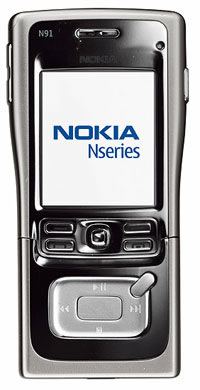 Speculation about
Speculation about  In a making-the-most-out-of-a-difficult-situation way, Kari went on to say, “But since this is based on a computer platform, anybody — including Apple if they so wish — can very easily develop this kind of application and offer it to consumers, via the Internet for example.”
In a making-the-most-out-of-a-difficult-situation way, Kari went on to say, “But since this is based on a computer platform, anybody — including Apple if they so wish — can very easily develop this kind of application and offer it to consumers, via the Internet for example.” It seems that there’s a never ending supply of companies ready to shell out for surveys asking the most inane questions.
It seems that there’s a never ending supply of companies ready to shell out for surveys asking the most inane questions.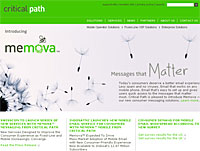 Plundering the depths of inanity further, the survey revealed that 34 per cent of females ranked spouse emails as the most important, and 10 per cent more blokes reckoned mobile email would make their lives easier. Fascinating.
Plundering the depths of inanity further, the survey revealed that 34 per cent of females ranked spouse emails as the most important, and 10 per cent more blokes reckoned mobile email would make their lives easier. Fascinating.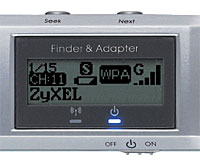 ZyXEL’s new AG-225H Wi-Fi Finder is an ideal tool for hotspot-hunting consumers, hackers, freeloaders and bandwidth bandits.
ZyXEL’s new AG-225H Wi-Fi Finder is an ideal tool for hotspot-hunting consumers, hackers, freeloaders and bandwidth bandits.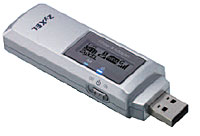 The AG-225H claims to be the first gizmo to combine an 802.11a and 802.11b/g USB 2.0 adapter with a fully functional stand-alone hotspot detector, allowing users to turn their laptops into an access point and share their wireless access with others.
The AG-225H claims to be the first gizmo to combine an 802.11a and 802.11b/g USB 2.0 adapter with a fully functional stand-alone hotspot detector, allowing users to turn their laptops into an access point and share their wireless access with others. One of the real benefits of carrying around one of these puppies is that you don’t have to wander about with a booted-up laptop to see if there’s any Wi-Fi in the air, so the US$99 AG-225 could prove invaluable for security professionals looking for any unsecured access points.
One of the real benefits of carrying around one of these puppies is that you don’t have to wander about with a booted-up laptop to see if there’s any Wi-Fi in the air, so the US$99 AG-225 could prove invaluable for security professionals looking for any unsecured access points.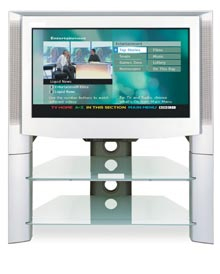 A couple of stories have been circulating about the BBC of late, both concerning their adoption of digital TV.
A couple of stories have been circulating about the BBC of late, both concerning their adoption of digital TV.